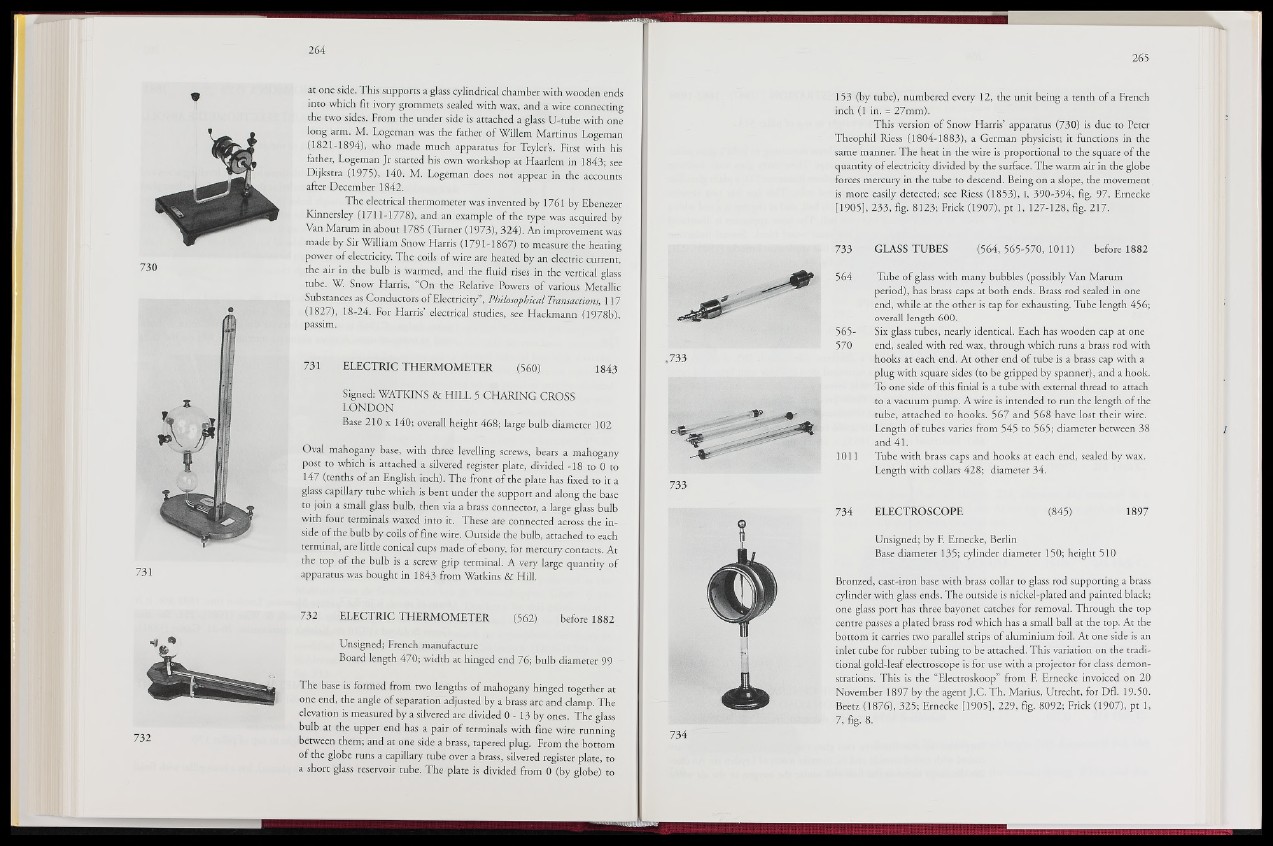
730
at one side. This supports a glass cylindrical chamber with wooden ends
into which fit ivory grommets sealed with wax, and a wire connecting
the two sides. From the under side is attached a glass U-tube with one
long arm. M. Logeman was the father of Willgm Martinus Logeman
(1821-1894), who made much apparatus for Teyler’s. First with his
father, Logeman Jr started his own workshop at Fïaarlem in 1843; see
Dijkstra (1975), 140. M. Logeman does not appear in the accounts
after December 1842.
The electrical thermometer was invented by 1761 by Ebenezer
Kinnersley (1711-1778), and an example of the type was acquired by
Van Marum in about 1785 (Turner (1973), 324). An improvement was
made by Sir William Snow Harris (1791-1867) to measure the heating
power of electricity. The coils of wire are heated by an electric current,
the air in the bulb is warmed, and the fluid rises in the vertical glass
tube. W Snow Harris, On the Relative Powers of various Metallic
Substances as Conductors of ll||tric ity ”, Philosophical Transactions, 117
..(1827), 18-24. For Harris’ electrical studies, see Hackmann (.1978b),
passim.
731 ELECTRIC THERMOMETER (560) 1843
Signed: WATKINS & HILL 5 CHARING CROSS
LONDON
Base 210 x 140; overall height 468; large bulb diameter 102|
Oval mahogany base, with three levelling screws, bears a mahogany
post to which is attached a silvered register plate, divided -18 to 0 to
147 (tenths of an English inch). The front of the plate has fixed to it a
glass capillary tube which is bent under the support and along the base
to join a small glass bulb, then via a brass connector, a large glass bulb
with four terminals waxed into it., These are connected across the inside
of the bulb by coils of fine wire. Outside the bulb, attached to each
terminal, are little conical cups made of ebony,, for mercury contacts. At
the top of the bulb is a screw grip terminal. A very large quantity of
apparatus was bought in 1843 from Watkins & H i l | |
732 ELECTRIC THERMOMETER (562) before 1882
Unsigned; French manufacture
Board length 470; width at hinged end 76; bulb diameter 99
The base is formed from two lengths of mahogany hinged together at
one end, the angle of separation adjusted by a brass arc and clamp. The
elevation is measured by a silvered arc divided 0 -13 by ones. The glass
bulb at the upper end has a pair of terminals with fine wire running
between them; and at one side a brass, tapered plug. From the bottom
of the globe runs a capillary tube over a brass, silvered register plate, to
a short glass reservoir tube. The plate is divided from 0 (by globe) to
153 (by tube), numbered every 12, the unit being a tenth of a French
inch (1 in. - 27mm).
This version of Snow Harris’ apparatus (730) is due to Peter
Theophil Riess (1804-1883), a German physicist; it functions in the
same manner. The heat id1 the wire is proportional to the square of the
quantity of electricity divided by the surface. The warm air in the globe
forces mercury in the tube to descend. Being on a slope, the movement
is more easily detected; see Riess f1853); I, 390-394, fig. 97. Ernecke
[1905], 233, fig. 8123f Frick (1907), pt 1, 127-128, fig. 2 1 7 .:
733 GLASS TUBES (564,565-570, 1011) before 1882
564 Tube of glass with many bubbles (possibly Van Marum
period), has brass caps at both ends. Brass rod sealed in one
end, while at the other is Tap for exhausting. Tube length 456;
overall length 600.
565- Six glass tubes, nearly identical. Each has wooden cap at one
570 end, sealed with red wax, through which runs a brass rod with
hooks at each end. At other end of tube is a brass cap with a
plug with square sides (to be gripped by spanner), and a hook.
To one side5 of this fmial is a tube with external thread to attach
to a vacuum pump. A wire is intended to run the length of the
tube, attached to hooks. 567 and 568 have lost their wire.
Length of tubes varies from 545 to 565; diameter between 38
and 41.
1011 Tube with brass caps and hooks at each end, sealed by wax.
Length with collars 428; diameter 34.' ’
734 ELECTROSCOPE (845) 1897
Unsigned; by F. Ernecke, Berlin
Base diameter 135; cylinder diameter 150; height 510
Bronzed, cast-ii;6n base with brass collar to glass rod supporting a brass
cylinder with glass ends. The outside is nickel-plated and painted black;
one glass port has three bayonet catches for removal. Through the top
centre passes a plated brass rod which has a small ball at the top. At the
bottom it carries two parallel strips of aluminium foJiAt one side is an
inlet tube for rubber tubing to be attached. This variation on the traditional
gold-leaf electroscope is for use with a projector for class demonstrations.
This is th'e: “Electroskoop” from F. Ernecke invoiced on 20
November 189|gfejthe agent J.C. Th. Marius, Utrecht, for DflL 19.50.
Beetz (1876), 325; Ernecke [1905], 229, fig. 8092; Frick (1907), pt 1,
I %• 8.